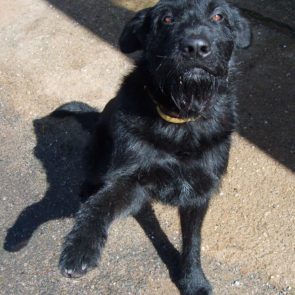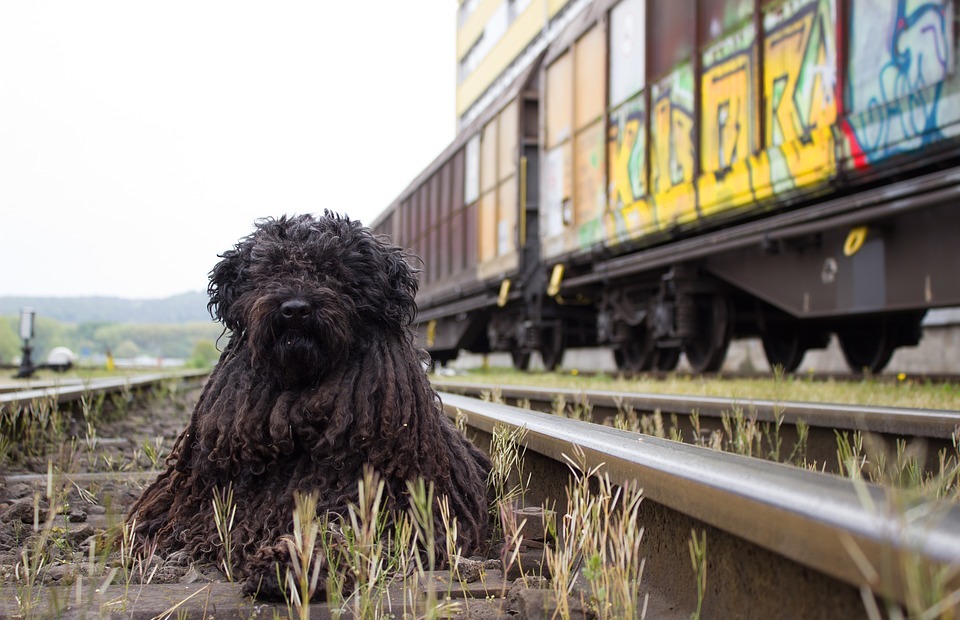Growing up with dogs, I've always been captivated by their unique ways of communicating. While their barks, growls, and whimpers are pretty easy to decipher, the tail wag has always been a bit of a mystery. Is a wag always a sign of happiness? Are there different types of wags, each with its own meaning? This constant curiosity led me down the rabbit hole of canine behaviour. Turns out, a dog's tail is much more than just a fluffy appendage. It's a powerful tool for expressing emotions, and learning to read its subtle cues can significantly enhance our understanding and bond with our furry friends.
(Part 1) The Science of Tail Wags

Before we dive into the fascinating world of tail wag interpretations, let's understand the science behind this behaviour. A dog's tail is a complex structure composed of muscles and bones, just like our own. These muscles are controlled by the nervous system, which receives signals from the brain. When a dog is experiencing an emotion, its brain sends signals to the tail muscles, causing them to contract and move in a specific way.
1.1 The Role of the Brain
Intriguingly, studies have revealed that different areas of the brain are involved in tail wagging depending on the emotion being expressed. For instance, when a dog is feeling happy and excited, the left side of their brain is more active, resulting in a tail wagging to the right. Conversely, when a dog is feeling threatened or stressed, the right side of their brain is more active, and they may wag their tail to the left.
1.2 Tail Wagging and Body Language
It's crucial to remember that tail wagging is just one piece of the puzzle when deciphering a dog's communication. To truly grasp what your dog is trying to say, you need to pay attention to a plethora of other cues like their ears, eyes, posture, and even their vocalizations. The tail wag is a part of a symphony of signals that paints a complete picture of their emotional state.
(Part 2) The Language of Tail Wags

Now that we have a basic understanding of the science, let's delve into the diverse world of tail wags and what they mean. It's not always as straightforward as "wagging = happy." A dog's tail wag can be a complex form of communication, influenced by several factors, including breed, age, personality, and individual experience.
2.1 The Happy Wag
The classic, relaxed, and rhythmic wag to the right is the most common sign of happiness and excitement. You'll often see this wag when a dog is greeted by their owner, given a treat, or playing with their favourite toy. The tail wag is often accompanied by other happy body language signals, like a relaxed posture, playful ears, and a loose, open mouth. It's like a joyful dance that says, "I'm so happy to see you!"
2.2 The Uncertain Wag
This wag is often a little slower and less enthusiastic than the happy wag. The dog's tail may be held lower, and the movement might be more subtle. It can mean that the dog is feeling a bit unsure or anxious, but not necessarily fearful. Think of it as a "wait and see" response. They’re taking in the situation and assessing the potential threat. It's like they're saying, "I'm not sure about this, but I'm not going to jump to conclusions."
2.3 The Defensive Wag
This is a wag to the left, often accompanied by a lowered tail, hunched posture, and flattened ears. This can indicate that the dog is feeling threatened or stressed. They’re trying to appear smaller and less threatening. It’s crucial to respect their space and not approach them forcefully. Instead, try to calm them down with a soothing voice and gentle body language. It's like they're saying, "I'm feeling scared and want to avoid conflict."
2.4 The Aggressive Wag
While it might seem counterintuitive, a dog can wag its tail even when it’s feeling aggressive. This wag is often fast and stiff, sometimes with a slight downward flick at the end. The dog’s tail may be held high and rigid, and their body language will be tense. The aggressive wag is a warning sign, and it’s important to back away and avoid confrontation. It's like they're saying, "Back off! I'm not happy about this situation."
(Part 3) Tail Wags in Different Breeds

Adding another layer of complexity, the way a dog wags its tail can vary depending on its breed. Certain breeds tend to have exaggerated tail wags, while others have more subtle movements. For instance, a Husky or a German Shepherd might have a large, powerful wag, while a Beagle or a Dachshund might have a more subtle, almost quivering, wag. Understanding breed-specific communication can help you interpret tail wags more accurately. It's like learning the different dialects of a language.
(Part 4) Reading the Full Picture
While tail wagging provides valuable insights into a dog's emotions, it's crucial to consider it alongside other body language cues. A dog’s posture, facial expressions, and vocalizations all contribute to the overall message they’re trying to convey. For example, a dog might be wagging its tail, but if it’s also growling or showing its teeth, it’s likely feeling threatened and defensive, not happy and playful.
4.1 Observing Body Language
Here are some key body language cues to watch out for:
- Ears: Relaxed and forward, or pinned back and flattened.
- Eyes: Wide and relaxed, or narrowed and intense.
- Mouth: Loose and open, or closed and tense with teeth bared.
- Posture: Relaxed and playful, or stiff and tense.
(Part 5) The Power of Observation
Just like understanding any language, learning to decipher a dog's tail wag takes time and practice. Spend time observing your own dog and other dogs in different situations. Pay attention to how their tail wags change based on their mood and surroundings. With time and patience, you’ll begin to notice the subtle differences in their tail wags and develop a better understanding of their communication. It's like learning a new language, where the more you practice, the more fluent you become.
5.1 Building a Stronger Bond
Understanding your dog’s tail wagging can be a powerful tool for building a stronger bond with them. It allows you to connect with them on a deeper level and respond to their needs more effectively. When you can recognize what they’re trying to communicate, you can create a more peaceful and harmonious relationship. It’s a way of showing them you understand them and respect their feelings. It's like unlocking a secret language that deepens your connection.
(Part 6) Tail Wagging in Different Contexts
Tail wagging isn’t just a simple response to a stimulus. It’s a nuanced form of communication that can be influenced by the context in which it’s displayed. The same tail wag might mean different things depending on the situation.
6.1 Meeting a New Dog
When a dog meets a new dog, the tail wag might be a sign of greeting or curiosity. But it could also indicate nervousness or tension. Pay attention to other body language cues, like whether the dog is holding its tail high or low, whether it’s stiff or relaxed, and whether it’s maintaining eye contact or avoiding it. It's like reading the subtle nuances of a conversation, where context plays a key role.
6.2 Playing with Toys
A dog's tail wag during playtime is usually a sign of joy and excitement. But if the wag becomes excessive and stiff, with the dog’s tail held high, it might indicate over-excitement or frustration. In this case, it’s best to take a break from playtime and allow the dog to calm down. It's like understanding the difference between a playful giggle and an irritated sigh.
6.3 Encountering a Stranger
A dog's tail wag when encountering a stranger can be a sign of friendliness, but it could also be a sign of nervousness or even aggression. Look for other cues, like whether the dog is wagging its tail to the right or left, whether it’s relaxed or tense, and whether it’s maintaining eye contact or avoiding it. It's like recognizing a friendly smile versus a forced one.
(Part 7) The Importance of Consistency
While learning to decipher a dog's tail wag can be fascinating, it's important to remember that every dog is an individual. While there are general guidelines, some dogs may express themselves differently. The key is to observe your dog regularly and pay attention to the nuances of their behaviour. Over time, you'll develop a deep understanding of your dog’s unique communication style. It's like recognizing a friend's unique voice and mannerisms.
(Part 8) FAQs
8.1 Do all dogs wag their tails?
While most dogs wag their tails, some breeds, like the Basenji, are known for not wagging their tails at all. It’s also important to remember that individual dogs can have their own unique communication styles. Some dogs might not wag their tails even if they’re happy, and others might wag their tails in ways that seem unusual. It's all about learning to recognize your dog’s specific signals.
8.2 Can a dog wag its tail when it’s scared?
Yes, a dog can wag its tail even when it’s scared or anxious. It’s important to consider the context and look for other body language cues, like a lowered tail, flattened ears, or a tense posture. A fearful wag is often slower and less enthusiastic than a happy wag.
8.3 What should I do if my dog wags its tail aggressively?
If your dog is wagging its tail aggressively, it’s important to respect their space and avoid confrontation. Back away slowly, and try to calm them down with a soothing voice and gentle body language. If the behaviour continues, it’s best to consult with a professional dog trainer or behaviourist.
8.4 Can tail wagging be trained?
While tail wagging is an instinctive behaviour, you can train your dog to respond to certain cues by associating them with positive rewards. For example, you can teach your dog to wag its tail on command. This can be useful for teaching tricks or helping your dog overcome anxiety in certain situations.
8.5 What are some resources for learning more about dog communication?
There are many excellent resources available for learning more about dog communication, including books, websites, and online courses. You can also consult with a professional dog trainer or behaviourist who can provide you with personalized guidance based on your dog’s individual needs.
Understanding a dog’s tail wag is more than just a cute quirk. It’s a window into their inner world, their thoughts, and their emotions. It’s a powerful tool for building a deeper bond with your furry friend. By learning to read their tail wag, you can strengthen your connection with them and create a more harmonious relationship. It’s about more than just understanding their tail wag; it’s about understanding their language, their heart, and their soul.
Everyone is watching
-

Can Dogs Eat Bananas? A Guide to Safe Treats
DOGS & PUPPIESThis comprehensive guide will delve into the world of canine nutrition, focusing on the popular question: can ...
-

Can Dogs Eat Oranges? (Is It Safe or Toxic?)
DOGS & PUPPIESThis article delves into the question of whether dogs can safely consume oranges. We'll explore the nutrition...
-

Can Dogs Eat Grapes? The Shocking Truth About This Fruit
DOGS & PUPPIESThis article delves into the controversial topic of grapes and dogs, exploring the potential dangers associate...
-

Why Do Dogs Eat Poop? Understanding Coprophagia in Dogs
DOGS & PUPPIESThis article delves into the perplexing phenomenon of coprophagia, the act of eating faeces, in dogs. We explo...
-

Can Dogs Eat Shrimp? A Guide to Safety and Risks
DOGS & PUPPIESThis comprehensive guide dives into the world of shrimp and dogs, exploring the potential benefits and risks a...
